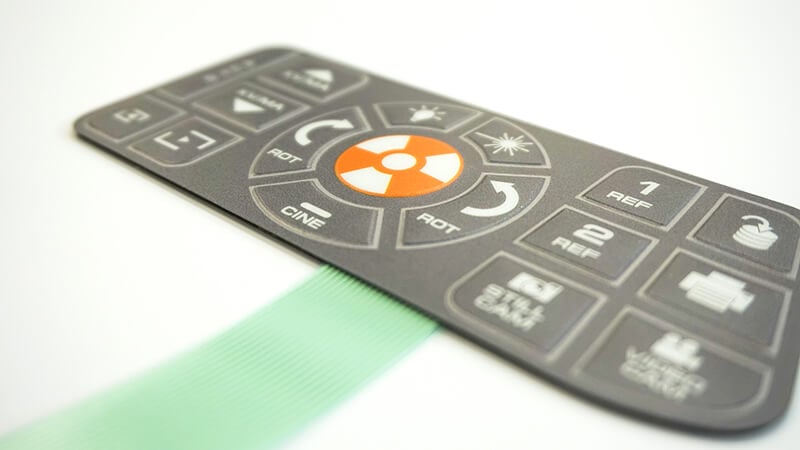The Function of a Membrane Switch in Modern Touch Interfaces and Controls
The Function of a Membrane Switch in Modern Touch Interfaces and Controls
Blog Article
Just How Membrane Layer Switches Contribute to the Sturdiness of Electronic Control Panels
Membrane layer buttons play an essential role in boosting the toughness of digital control panels, mostly through their multi-layered building which gives efficient defense against environmental variables such as dampness and dust. The lack of relocating parts substantially reduces the likelihood of mechanical failings, making membrane layer switches perfect for demanding applications.
Meaning of Membrane Switches

Membrane layer switches are created to be thin and light-weight, making them ideal for applications where room is limited. They can be produced in numerous forms, sizes, and shades, offering flexibility in style that meets aesthetic and useful demands. Additionally, membrane switches can incorporate various technologies, such as responsive responses and LED indications, boosting user experience.
As a result of their construction, membrane buttons are often resistant to dust, dampness, and basic wear, adding to their toughness in requiring atmospheres. Their smooth style not only facilitates simple cleaning yet additionally reduces the risk of mechanical failing, making them a preferred choice for manufacturers looking for trustworthy interface in their electronic control board.
Defense Versus Ecological Variables
The style of membrane switches over naturally offers a degree of defense against numerous environmental factors, which is essential for keeping capability in difficult problems - Membrane Switch. These switches are commonly constructed with layers of adaptable products that shield inner elements from dampness, dirt, and pollutants. By encapsulating the wiring, membrane changes reduce the risk of short circuits and rust, which can dramatically impair performance
Moreover, using robust adhesives and sealants during production boosts their resistance to environmental obstacles. Membrane layer switches can endure exposure to chemicals and solvents, making them suitable for industries such as food handling and health care, where health and tidiness are extremely important. Their seamless surface area design likewise prevents the accumulation of dirt and microorganisms, assisting in less complicated cleansing and maintenance.
Temperature changes are another environmental concern, and membrane buttons are crafted to work successfully throughout a wide array of temperature levels (Membrane Switch). This flexibility makes sure that control board stay functional in different setups, from commercial atmospheres to consumer electronics
Influence on Individual Interaction
Individual communication with digital control panels is dramatically affected by the design more info here and performance of membrane layer switches. These switches offer a responsive user interface that enhances the general user experience, permitting for user-friendly navigation and control. Their responsive nature makes sure that customers receive instant comments upon activation, which is critical for tasks needing precision and effectiveness.
Furthermore, the smooth surface area of membrane layer switches promotes simple cleaning and maintenance, promoting individual self-confidence in the integrity of the user interface. This sanitation is especially important in environments where health is critical, such as medical or food handling settings. Additionally, the compact and lightweight layout of membrane changes adds to the aesthetic charm of control panels, urging user engagement through a modern and smooth look.
In addition, the combination of visual aspects, such as printed icons and backlighting, assists users swiftly identify features, reducing the finding out curve connected with brand-new tools. Therefore, customers can run tools better, resulting in increased performance and satisfaction. In recap, membrane buttons play a critical function in boosting individual interaction by integrating capability, aesthetic appeals, and convenience of usage, eventually causing boosted operational performance.
Design Versatility and Personalization
Design versatility and modification are important elements of membrane buttons, enabling makers to tailor electronic control board to certain applications and customer requirements. This versatility enables for the integration of different layout components, such as colors, graphics, and structures, which can improve the visual charm and individual involvement of the control panel.
Membrane buttons can be tailored in shapes and size, accommodating a wide range of tools and applications, from commercial equipment to consumer electronics. This versatility makes sure that makers can develop intuitive user interfaces that line up with user expectations and operational requirements. Furthermore, the ability to integrate one-of-a-kind attributes such as backlighting or responsive responses even more improves usability, permitting a more interactive experience.
Additionally, the manufacturing process for membrane layer switches over supports the quick prototyping of layouts, allowing suppliers to iterate and refine their concepts promptly. This capacity not just increases the advancement timeline however also guarantees that the last product satisfies his comment is here particular useful and visual requirements.

Cost-Effectiveness and Longevity
Cost-effectiveness and long life are significant advantages of membrane special info layer switches, making them an appealing alternative for suppliers and end-users alike. These switches are generally much less expensive to create than typical mechanical buttons, largely as a result of their simplified manufacturing processes and the decreased number of parts called for. This expense benefit prolongs not just to first production yet additionally to long-term functional expenditures, as membrane buttons often need much less maintenance and have a lower failure rate.
In addition, the longevity of membrane switches adds to their general value. Constructed from sturdy materials, they are resistant to ecological elements such as dampness, dust, and chemicals, which can lead to premature wear in other button kinds. The absence of relocating parts reduces mechanical failure, enabling membrane layer switches over to keep capability over expanded periods.
This longevity is particularly valuable in applications requiring regular efficiency under demanding conditions, such as medical devices and industrial tools. Eventually, the combination of cost-effectiveness and durability makes membrane switches a financially viable selection for suppliers, giving reliable solutions that withstand the test of time while maximizing financial considerations.
Verdict
In final thought, membrane layer switches considerably boost the longevity of electronic control panels via their robust construction and protective features - Membrane Switch. In general, membrane switches represent a trusted and cost-effective option for boosting the durability and functionality of digital control systems.
Report this page